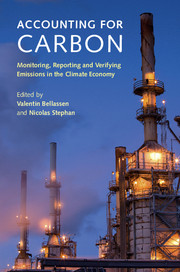Book contents
- Frontmatter
- Contents
- List of figures and map
- List of tables
- List of boxes
- Notes on contributors
- Acknowledgements
- 1 Introduction: key notions and trade-offs involved in MRVing emissions
- Part I MRV of territorial/jurisdictional emissions
- Part II MRV of industrial sites and entities
- 5 Trendsetter for companies and industrial sites: the EU Emissions Trading Scheme
- 6 Variant 1: the waste sector in Australia's Carbon Pricing Mechanism, another ETS at site level
- 7 Variant 2: non-site level emissions in an ETS–the case of electricity importers in the California cap-and-trade
- 8 Variant 3: emissions of a company/institution rather than a site: the case of the Shenzhen ETS
- 9 Variant 4: coexistence of voluntary and mandatory frameworks at the company level - Carbon Disclosure Project, EU ETS and French legal requirements
- 10 Direct measurement in the EU ETS
- Part III MRV at offset project scale
- Index
- References
7 - Variant 2: non-site level emissions in an ETS–the case of electricity importers in the California cap-and-trade
from Part II - MRV of industrial sites and entities
Published online by Cambridge University Press: 05 March 2015
- Frontmatter
- Contents
- List of figures and map
- List of tables
- List of boxes
- Notes on contributors
- Acknowledgements
- 1 Introduction: key notions and trade-offs involved in MRVing emissions
- Part I MRV of territorial/jurisdictional emissions
- Part II MRV of industrial sites and entities
- 5 Trendsetter for companies and industrial sites: the EU Emissions Trading Scheme
- 6 Variant 1: the waste sector in Australia's Carbon Pricing Mechanism, another ETS at site level
- 7 Variant 2: non-site level emissions in an ETS–the case of electricity importers in the California cap-and-trade
- 8 Variant 3: emissions of a company/institution rather than a site: the case of the Shenzhen ETS
- 9 Variant 4: coexistence of voluntary and mandatory frameworks at the company level - Carbon Disclosure Project, EU ETS and French legal requirements
- 10 Direct measurement in the EU ETS
- Part III MRV at offset project scale
- Index
- References
Summary
Acknowledgements: We are grateful to Wade McCartney (California Air Resource Board) and David Edwards (California Air Resource Board) for their answers to our questions.
Context
Electricity in carbon pricing mechanisms
Most cap-and-trade schemes developed or in development in the world at least regulate CO2 emissions from the electricity sector. Several specifications may facilitate the inclusion of this power sector under this kind of regulation:
• the electricity sector is usually responsible for a large share of CO2 energy emissions – 12 billion tons or 40 percent CO2 energy emissions globally;
• some low-cost CO2 emission reductions opportunities exist within the sector such as fuel-switching (Ellerman et al., 2010; IEA, 2012);
• the electricity sector is usually not at risk of carbon leakage, as international electricity trades are greatly limited by grid connections, and operators can therefore pass on the costs of carbon allowances to consumers in the price of electricity.
In terms of monitoring, reporting and verification of its CO2 emissions, the power sector offers some inherent advantages: large point sources, relatively few flows to monitor, fuel inputs traded and therefore measured, some data and reporting structures available from pre-existing regulation and a limited number of companies involved.
In most developed or developing cap-and-trade schemes, the electricity sector is covered at the production level – electricity producers rather than consumers are capped – and the regulation only applies to power plants located within the regulator's jurisdiction. However, the cap-and-trade scheme in California presents a specificity for the power sector: the regulation also covers the electricity imported from neighboring States. Another example of covering Greenhouse Gas (GHG) emissions from electricity consuming emissions and entities located outside the regulator's jurisdiction is the Shenzhen Emission Trading Scheme (ETS) pilot, see Chapter 8. From this angle, the Californian law is – to our knowledge – the first instance of a border carbon adjustment and, as such, a very interesting testing ground.
- Type
- Chapter
- Information
- Accounting for CarbonMonitoring, Reporting and Verifying Emissions in the Climate Economy, pp. 221 - 262Publisher: Cambridge University PressPrint publication year: 2015



